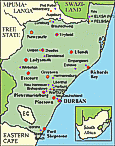- The Bergtheil Colonists, who arrived in 1847, and
- The Hermannsburg missionaries and colonists who started arriving in 1854.
The Bergtheil or Bramsche Colonists
In the early 1840's, just after the colony of Natal had been annexed by the British, the Natal Cotton Company was established. One of its directors, Jonas Bergtheil, went to Germany to attract settlers to Natal to grow cotton for the Company. After much searching, he found a group of people in the area of Bramsche, Osnabrücker Land, Kingdom of Hanover (now in Lower Saxony) who were willing to try their luck in this new colony.
The Bergtheil colonists settled in New Germany, Westville, just outside Port Natal (later renamed Durban). Initially they attempted to grow cotton, but soon failed. Some managed to make a living by supplying vegetables to the growing port town of Durban. The Natal Cotton Company disbanded and many of the settlers moved inland to Pietermaritzburg and the area around New Hanover.
It is largely due to the presence of the Bergtheil colonists, and epecially their pastor, Missionary Posselt of the Berlin Missionary Society, that the first group of Hermannsburg missionaries decided to settle in Natal, after their entry to Ethiopia had been blocked.
The Hermannsburgers
The Hermannsburg Missionary Society was founded by Louis Harms in Hermannsburg, Kingdom of Hanover (now in Lower Saxony). Its aim was to bring the gospel to the people of Africa and especially the Gallas of Ethiopia. After their entry to North East Africa had been blocked by Sultan Said of Zanzibar and Mombasa, they made South Africa the main focus of their missionary activity.
The Hermannsburg Missionary Society was a society of very limited means. It has been called a "farmers' missionary society" because it recruited its missionaries and colonists largely from the rural population of the Lüneburger Heide, the area in which Hermannsburg in Germany lies. While the missionaries were often not highly educated people, they were very motivated and established many missionary stations throughout the old Natal and Transvaal.
The missionaries and their descendants settled in areas of Central Natal, north of Pietermaritzburg, around Wartburg, Harburg, Lilienthal, further north around Hermannsburg, in Northern Natal around Dundee, Glencoe, Vryheid and Paulpietersburg, and on the South Coast around Marburg and Paddock.
 Map of German Lutheran Settlements in KwaZulu-Natal (40kB)
Map of German Lutheran Settlements in KwaZulu-Natal (40kB)
The Natal German Dialect
The dialect spoken by the people in the Lüneburger Heide formed the basis of the German spoken by the Natal Germans (Natalerdeutsch). It is distinguished by a few noticeable features:
- its rolled R,
- its round L,
- the pronunciation of the final syllable "er" as "ä" rather than "äa", and
- by the absence of the 3rd or Dative case.
"Das Vieh is übä die fence gejömpt und hat den cabbage gedamaged."
(The cattle jumped over the fence and damaged the cabbage).
Church life and schools
From the beginning, both churches and schools have been built in German settlements all over KwaZulu-Natal. The Lutheran Church is by far the most dominant of churches in these areas, even though various splits and divisions have occurred. Most congregations have their own local Primary Schools, with the older children being sent to boarding schools such as the private German school in Hermannsburg.
Family History
The Natal Germans are very proud of their German heritage (eg. the Küsel family). Many families have produced their own genealogies and family histories. A project has been started by Mr Walter Volker to collect all information available on the Natal German families and to incorporate it in a central database. He has collected information on more than 50 000 individuals, and many families are largely complete. Books have been produced for the larger families and are available for sale (at a price that covers the costs).
Further information:
- Surnames of the Natal Germans.
- A bibliography of books dealing with the Natal Germans, some of which are still available for sale.